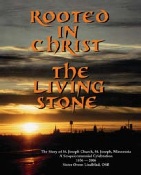Rooted in Christ
The Story of St. Joseph Church, St. Joseph, Minnesota
Sister Owen Lindblad, OSB
Page 56
All of these trials and tribulations of the 1990s sadly peaked with the sudden loss of the pastor, Tom Gillespie, OSB. Perhaps he couldn’t deal with another tragedy, folks thought–but they didn’t know. On February 23, 1996, Father Tom was gone. Some recall that there may have been some explanation given by Abbot Timothy, OSB, of Saint John’s, but nothing that really answered people’s questions. Father Daniel Ward, OSB, from Saint John’s, stepped in as interim pastor.
Page 56 & 57
However, only in June 2002, did parishioners receive real information about Father Tom. John Klassen, OSB, abbot of Saint John’s, visited with parishioners at an open meeting in the Parish/School Center. He informed them that Father Tom had been recalled due to an episode of child sexual misconduct–not at the St. Joseph Parish but at another parish many years before. By this time, parishioners also knew that a previous associate pastor had been recalled to the Abbey because of child sexual misconduct.
See Also: History of Misconduct in St. Joseph
See Also: Abbey Uses Timothy Kelly’s Obituary to Rewrite History
Order Form: http://www.churchstjoseph.org/pdfs/Rooted-in-Christ.pdf
The first Mass in the town of St. Joseph, then called Clinton, was celebrated by the veteran missionary, Father Francis Xavier Pierz on October 22, 1854 at the invitation of the settler families of Peter Loso, John Linnemann, and Peter Kraemer. Fr. Pierz convinced these German settlers to build a church, which was completed the following year. In 1860 the education of children in the area was assured by the building of a small log school that was attached to the Church.
In the following decade, a community of Benedictine monks and sisters arrived in the area and would take on pastoral leadership. Fr. Bruno Reiss, O.S.B. would be installed as the first resident pastor in 1856 and the sisters, whose convent and school would become the centerpiece of town, would begin a long relationship with the parish school.
In 1867 parishioners decided to build a more spacious church, a 66 x 150 foot edifice with the lower half composed of native field stones and the upper part of granite brick obtained from the nearby quarry. Since it was composed of permanent materials, it was consecrated by Bishop Thomas Grace on June 29, 1871 as the first consecrated church in Minnesota. That structure remains today, though the interior has undergone renovations, the last and most significant being in 1971 to adapt it to post-Vatican II liturgical celebration and theological norms.
When the sisters College of Saint Benedict initiated a degree program in education, the St Joseph school became a laboratory for training hundreds of teachers. In 1970 the name of the school was changed to reflect this relationship. Although the name of the school remains the Saint Joseph Laboratory School, the college no longer uses the school for training of their teachers. Today, the school continues to have a close relationship with the College of Saint Benedict and Saint Benedicts Monastery and has approximately 175 students from pre-school through sixth grade.
The Church of Saint Joseph has a rich tradition that is a real source of strength as it looks to the future. Fr. Joseph Feders, OSB serves as pastor to the 1,200 families that make up the parish community.
To learn more about the history of the Church of Saint Joseph, you may order the book Rooted in Christ: The Living Stone.



